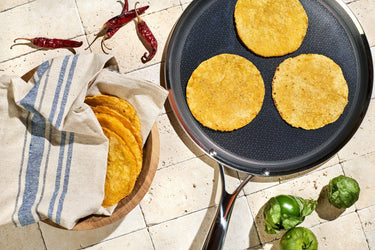8 Tips for Tastier Homemade Tortillas
Few things elevate a meal like a freshly made tortilla. Maybe it’s the earthy corn flavor wrapped around melty shrimp and cheese in Tacos Gobernador, or the way a flour tortilla crisps and puffs on a hot pan, ready to be loaded with fajita fixings. Whatever the application, a good tortilla sets the tone for a great meal. To help you get the most out of your masa (or your flour), we asked chef Maricela Vega to share her go-to tips so you can nail her Homemade Corn and Flour Tortilla recipes every time.
1. Say no to store-bought
If you’re wondering whether it’s worth the effort to make your own tortillas, chances are you haven’t tasted one fresh off the griddle. “The number one reason to make them at home is the taste. It’s going to amplify all your effort,” Maricela says. “The tortilla is automatically going to give you a better product because chemicals and other preservatives flatten the flavor of grocery store tortillas.” After putting in the work on dishes like Birria de Borrego or Tikin Xic (Fish Roasted in Banana Leaves), serving them with lackluster vehicles is a disservice. And in recipes like Enfrijoladas, where the tortilla is a key component, homemade makes a noticeable difference in every bite.
2. Adequate hydration = good dough
Maricela emphasizes that hydrating the dough—in other words, giving it time to rest after you’ve added the water—is crucial to making great tortillas. “One of the downsides to creating anything from scratch is time,” she says, but this step is non-negotiable. For flour tortillas, “you’re looking for a nice, plush ball that you can press on—not like a pasta dough where it bounces back immediately—but slightly gooier.” Corn dough should have a texture closer to pasta dough: “When you dip your fingers into it, you should find a bit of resistance.” As for how long to rest it, “Forty-five minutes is the bare minimum for resting the dough if just want to get these done, but one day of rest is going to give you the best tortilla that you want to have." Her advice? Get in the habit of making your dough a day ahead; your tortillas will thank you. (Be sure to refrigerate the dough if you're working ahead.)

3. Dry tortillas are the enemy
Once your tortillas are cooked, resist the urge to simply toss them onto a plate and walk away. “Store them wrapped in linen,” Maricela advises. It helps lock in moisture and keeps them from drying out before you’re ready to eat. (Bonus: They'll look beautiful when you serve them!)
4. Choose your fave fat for flour tortillas
Pork lard is the traditional choice for flour tortillas, and Maricela includes it in her recipe. But she also suggests unsalted butter or coconut oil as alternatives, depending on your preferences. While the flavor difference isn’t huge, she notes that the texture and aftertaste do shift: Animal fats such as lard or butter offer a richer, creamier bite, while coconut oil makes for flakier tortillas. If you opt for coconut oil, go for a high-quality version so that any subtle coconut flavor is clean and pleasant. It won’t taste like a macaroon, she assures, just a faint note with which plant-based eaters are likely already familiar.
5. The masa matters
While mass-produced masa harina is easy to find, Maricela avoids overly processed brands that often include “ingredients that don’t necessarily belong to a proper nixtamal or corn dough.” Instead, she splurges on Masienda’s masa harina or picks up Bob’s Red Mill as a reliable alternative. Both are processed via nixtamalization, the traditional process of treating corn with lime (the chemical, not the citrus), which means the masa requires adequate hydration to create a supple dough. That rest time enhances the flavor and brings out the subtle toasted corn notes developed during nixtamalization. If you can smell those corn notes, she says, you’ve got a good product.
6. Inflation traps moisture
Even a small amount of trapped moisture can improve the texture of your tortilla, Maricela says. To get there, watch for the tortilla to begin inflating—bubbles are a good sign—then press gently with a spatula to help seal in the steam. “It adds more airiness and pliability to your tortilla," she explains.
7. A griddle is great
The traditional way to cook a tortilla is on a comal, a smooth, round pan with a flat surface. Our 13” Hybrid Griddle Pan is a close approximation, allowing you to cook multiple tortillas at once. If you want to cook even more, stretch out on a Double Burner Griddle.

8. No tortilla press? Fear not.
A tortilla press is one of the best tools for getting evenly shaped tortillas with the right thickness, and it’s worth investing in if you plan to make them often. But if you don’t have one yet, there are workarounds. Maricela recommends placing a ball of dough between layers of parchment or plastic and pressing it down with the heaviest item you’ve got handy. “If that doesn’t work, make sopes or gorditas. They’re a little thicker, maybe a little smaller. You can start from inwards and flatten your way out. Gorditas are like a burger patty. You just griddle them on slower heat and then throw them in the oven at 350ºF for six minutes or so to make sure your interior is done.”
Your homemade tortillas are ready to star in our collection of Mexican staples. We’ll be right over.
*Quotes have been edited and condensed for clarity.






